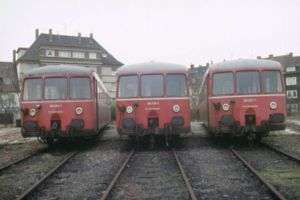DB Class ETA 150
| DB Class ETA/ESA 150 DB Class 515/815 | |
|---|---|
 | |
| Number(s) | ETA 515 001–033 ETA 515 101–138 ETA 515 501–661 ESA 150 001–216 |
| Quantity | 232 power cars 216 driving cars |
| Manufacturer | SSW, Rathgeber, O&K WMD, Wegmann & Co. |
| Year(s) of manufacture | 1955 |
| Retired | 1995 |
| Axle arrangement | Bo'2'(ETA) and 2'2'(ESA) |
| Type | BD4 or ABD4 and B4tr. |
| Length | 26.8 m (88 ft) (ETA) 26.8 m (88 ft) (ESA) |
| Empty weight | 49.0–56.0 t (48.2–55.1 long tons; 54.0–61.7 short tons) (ETA) |
| Top speed | 100 km/h (62 mph) |
| Power output (one hour) | 2× 150 kW (200 hp) = 300 kW (400 hp) |
| Range | 300 km (190 mi) |
| Capacity | 352–548 kWh (1,270–1,970 MJ) |
| Driving wheel diameter | 0.95 m (3 ft 1 in) |
| Carrying wheel diameter | 0.95 m (3 ft 1 in) |
| Brakes | Knorr |
| Seats | 59–86 (ETA) 81–100 (ESA) |
The accumulator cars of Class ETA 150 (Class 515 from 1968) were German railbuses used extensively by the Deutsche Bundesbahn (DB) over 40 years. The driving cars were very comfortable to travel in because they were quiet (despite the typical whine of its DC motors), rode well on the rails due to the weight of the batteries and were pollution-free (no smoke or fumes). They ran on both main and branch lines.
They were very popular with passengers. The vehicles were nicknamed Akkublitz (Battery Lightning), Säurebomber (Battery Acid Bombers), Steckdosen-InterCity (Socket InterCitys), Taschenlampen-Express (Pocket Torch Express) or Biene Maja (Maya the Bee - due to its noise when under way).
History
As a result of many years of favourable experience with this type of vehicle (the Prussian state railways had placed accumulator railcars in service as early as 1907 – these were later the Class ETA 178 in the Deutsche Reichsbahn) and evaluation of the results with the Class ETA 176 prototypes, the DB placed 232 Class ETA 150 power cars and 216 of their associated Class ESA 150 driving cars in service between 1953 and 1965.
The DB preferred to employ these two-coach sets on relatively level routes. They were rarely used on hilly lines due to the resultant high current consumption and hence limited range. In the main this only affected those vehicles stationed at Wanne-Eickel, and which were used in the Wuppertal area.
Its main areas of operation, apart from the Ruhrgebiet, were Schleswig-Holstein, eastern Lower Saxony, eastern Rhineland-Palatinate (in the Westerwald forest), south Hesse and south Baden. The last few railcars also worked in the area of the Rhine-Ruhr Transport Union (Verkehrsverbund Rhein-Ruhr) or VRR until 1995.
Between 1978 and 1988 the railcars also worked from Aachen to Maastricht in the Netherlands.
In 1968, under the DB’s renumbering scheme, the power cars became Class 515, and the driving cars Class 815.
Compared with the Prussian Wittfeld accumulator cars, the ETA 150s had an uneven weight distribution − the batteries were located in the middle of the coach body instead of over the bogies, so that in their last few years in service they tended to sag in the middle, which resulted in their nickname of Hängebauchschweine (Pot-bellied pigs).
Variants
Batches
- 515.0, 1954–1956; battery capacity: 352-437 kWh
- 515.1, 1956–1958; battery capacity: 390-437 kWh
- 515.5, 1959-1965: battery capacity: 520-603 kWh
Passenger compartments
The first batch had a high proportion of 1st class seating; this was changed for the second batch, the number of 1st class seats being reduced to just eight. All ETAs had a luggage compartment. The original 2+3 seat layout was changed in the later batches to a 2+2 configuration.
- 515 003-033
- 515 101-112, 120-138 (Hamburg variant)
- 515 113-119 (Bremen variant)
- 515 501-508, 639-651
- 515 509-580, 604-638, 652-661
Livery variations
The twin-car sets were delivered in a wine-red livery. From 1975 some were repainted to beige and ocean-blue. Shortly before their retirement a few vehicles were painted in the DB’s paint scheme at that time - white and peppermint green - and ran in this livery on the Nokia Railway (today the Glückauf Railway) from Bochum Hbf to Gelsenkirchen Hbf.
-

515 in red
-

515 in ocean-blue/beige
-

515 in peppermint green/white
Preserved

Two power cars were sold to the Regentalbahn (private railway), who converted them to diesel cars and designated them as Class VT 515-U.
Only a few vehicles could be preserved by museum railways because their maintenance is extremely difficult now that the maintenance of batteries at Limburg has ceased and the vehicles are required to go to charging stations. The maintenance and operation of normal railbuses is considerably easier. Number 515 556 is operational, but until it undergoes a general inspection it can only be used on the (museum) site of the locomotive depot.
The following have been preserved:
- 515 556-9 and 815 672-1 (Bochum-Dahlhausen Railway Museum)
- 515 011-5 (Bavarian Railway Museum at Nördlingen)
Sources
- Horst J. Obermayer: Taschenbuch Deutsche power car. Frankh'sche Verlagshandlung, Stuttgart 1973, ISBN 3-440-04054-2
- The Akkutriebwagen ETA 150 (515) and ETA 176 (517). Eisenbahnkurier Special Nr. 12. EK-Verlag, Freiburg in the Breisgau.
- Thomas Feldmann: Steckdosen-InterCity. Erinnerung an die Class 515. In: LOK MAGAZIN. Nr. 251/Jahrgang 41/2002. GeraNova Zeitschriftenverlag GmbH München, ISSN 0458-1822, S. 60-61.
External links
- Bavarian Railway Museum
- Bochum Railway Museum
- The ETA 150
- Railcar Lexicon
- Maintenance of a 515 at Bw Worms